Written by Peter M J Fisher (Adj. Professor, School of Architecture & Built Environment, Deakin University, Geelong, Australia)
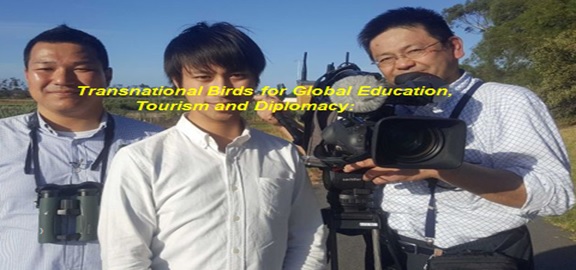
Wild Bird Society of Japan’s Senior Biologist, Dr Tatsuya URA (left) and accompanying HTB TV crew at Maffra, East Gippsland, Australia, 25th January 2017. Picture: Isabella Pittaway.
Concept
Transnational birds for education, tourism and diplomacy is an (applied) research and development initiative inspired by the remarkable immigration of Latham’s Snipe laid bare to an intrigued wider public by a tracker installed on a bird in Hokkaido in September 2016. This recorded a nonstop flight across the equator to just north of Australia in the space of 5-6 days (recent geolocator data confirms a similar duration northbound) – amounting to an average speed of ~100km per hour. It tallies with an average speed of 54km per hour (14 m per second) for Cranes along the European Flyway and is reflective of a bird built for speed. Do they, like the Crane, sense/utilise tailwinds??
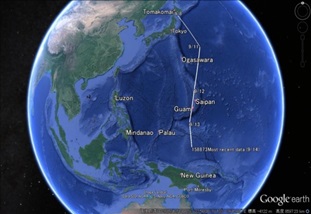
The flight trajectory of a Latham’s Snipe from Tomakomai, Hokkaido, as logged by a PTT100 satellite tracker. Image: The Snipe Project.
Transnational birds for education, tourism and diplomacy reaches across national/political boundaries to highlight an extraordinary story – one that Nature has been undertaking for thousands of years – of long distance transnational bird immigration.
Genesis: One bird – two hemispheres: Tomakomai and Maffra linked by Nature
Transnational birds for education, tourism and diplomacy grew out of the comradery spawned between peoples otherwise separated by vast distances but joined-at-the-hip by a bird aka Latham’s Snipe. This was on show in early 2017 when visitors from Hokkaido and Tokyo were taken to the Maffra wetland in the course of preparing a documentary on Latham’s Snipe. In the company of Gippsland locals and birdies, they were astonished to see large numbers of their snipe (flushed from the Phragmites) so far from their seat in Northern Japan.
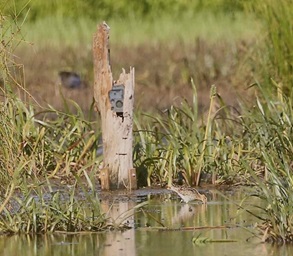
So far from their Hokkaido home: Latham’s Snipe at the Maffra wetland in January 2017, note the telemetrically linked camera trap..
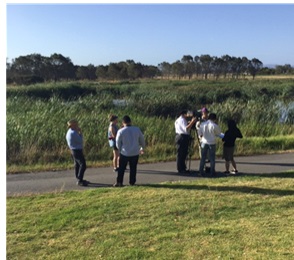
HTB TV Hokkaido crew filming at Maffra amidst local identities, Australian media and the Mayor of Wellington Shire, January 25th 2017.
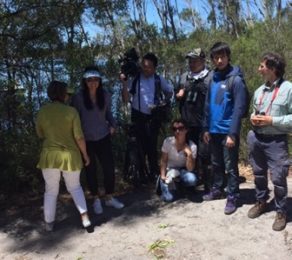
“..comradery spawned between peoples otherwise separated by vast distances but joined-at-the-hip by a bird aka Latham’s Snipe” Banksia Peninsula, Gippsland Lakes, 26th January 2017.
Practicalities
Transnational birds for education, tourism and diplomacy aims to harness advances in digital technology to both sense activity and ecological wellness of wetlands and their related habitats and display this via advanced graphics to a “connected” audience’ Its primary pitch is to emerging generations – esp. students.
A number of overwintering wetlands &/or breeding habitats for migratory birds (initially) in China, Japan and Australia will be selected. Australia has bi-lateral treaties with Japan and China to protect the habitat of migratory birds.
Digitally based sensing systems – notably telemetrically linked camera traps, audio and other sensors – will be installed and brought into operation. Local schools in both countries will be identified as recipients of display systems with an interactive capacity – a mirroring.
Children will have a degree of ownership – and an ability to interpret and convey their findings to their northern and southern counterparts respectively.
Moreover Transnational birds for education, tourism and diplomacy will, in collaboration with the East Asian & Australasian Flyway Partnership, seek to build bridges between university based research and schools with a large citizen science component.
The ultimate aim is to convey elements of bird flight, survival, etc., on a web site for global audiences and in the process generate mainstream support for maintaining all the essential elements of the ‘Flyway. Its historical digital record will further provide a finer scale understanding of the impact of climate change on individual habitats assisting with adaptation strategies.
Organisation
A Coordinating Group has been formed (December 2018) to establish a research cluster based on universities in China and Japan (including relevant programs of the Wild Bird Society of Japan). In Australia, founding universities will be RMIT, Melbourne, Federation, Deakin and Charles Sturt. Numbering amongst Chinese counterparts will be Hangzhou Normal and NIGLAS Nanjing. Schools will be recruited to the project at both ends of the flyway such as those in the Yangze delta.
A widening to other ‘Flyway Partnership countries is envisaged notably South Korea (a migratory birds treaty signatory with Australia) and the Russian Federation aka Southern Sakhalin and Siberia
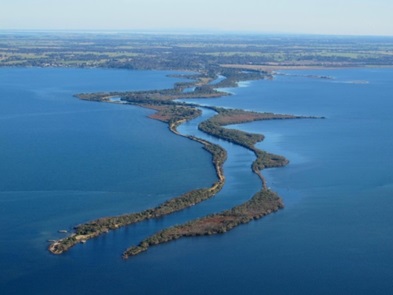
Ramsar designated Gippsland Lakes in South East Australia: A place of outstanding biogeography – all the more so for a deep seated avian connection to North Asia.




